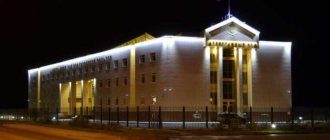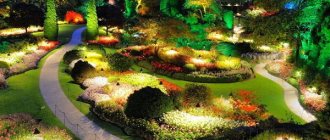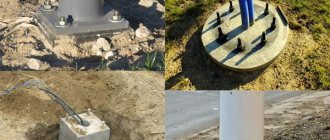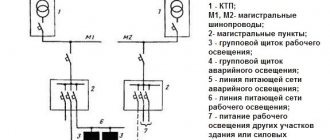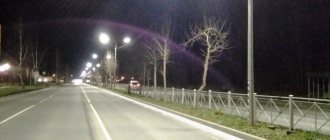Where to start calculating outdoor street lighting?
Comfort and safety are relative concepts, but they have certain indicators. There is no need to guess what level of illumination will be required for the street. It is enough to refer to the regulatory documents.
According to GOST R 55706-2013, road network objects are divided into classes, each of which requires a certain brightness of artificial light. The indicator is measured in candelas per square meter (cd/m2). Candel is a unit of luminous intensity.
For example:
· Class A (1.2-2.0 cd/m2) includes roads with heavy traffic (highways, federal highways).
· Class B (1-1,2) combines urban and regional routes.
· Class B (0.4-0.8) consists of roads in residential areas in the city center and beyond, as well as industrial areas.
· Class P (0.1-0.3) includes pedestrian streets, alleys, sidewalks, squares in front of public buildings.
You can also find in this GOST information regarding the average illumination of objects, measured in Lux (lx).
Values for the most popular objects:
· The area in front of the entrance to the entertainment building is 20,
· Pedestrian streets and playgrounds – 10,
· Entrance to the park or stadium – 6,
· Sidewalks – 4,
· Central and secondary alleys of parks – 2.
Another document that will help calculate street lighting is SNiP 05/23/95. Here are the values of horizontal illumination (lx) of many urban infrastructure objects:
· Bridges for pedestrians – 10,
· Sports grounds – 10,
· Approaches to various sites – 4,
· Shopping center area – 4.
SNiP 23-05-95 is also useful for calculating the external illumination of facades and shop windows, taking into account the requirements for facade brightness and the degree of reflection depending on the finishing material.
Features of lighting organization
Lighting of garden and park ensembles and other green areas is formed individually in accordance with established lighting standards for certain areas. This takes into account:
- features of the landscape and architecture of buildings and structures located in a park or square;
- traffic and level of attendance;
- green space density and area.
With the help of the lighting system, they form light accents on certain objects and areas, create lighting for flower beds and single bushes and trees, and mark the contours of the main alleys, additional paths and the perimeter of the park. Particular attention should be paid to playgrounds and sports grounds, and festive lighting should also be considered.
Methods for calculating outdoor lighting
Today in practice there are three methods used for lighting calculations of outdoor lighting :
· Spot – the essence of the method is to calculate indicators for each installed light source. Its advantage is the ability to calculate uneven light. And its main drawback is its labor intensity. This manual method requires special attention and pedantry of the designer.
· With luminous flux coefficient - an even more labor-intensive method that takes into account the reflectivity of objects, the distribution of radiation, and the use of luminous flux. Most often used for interior lighting design.
· The specific power method is the most popular among manual methods due to its simplicity (relative to the previous two options). With its help, you can find the required number of lighting fixtures, based on standard indicators and simple initial data.
Depending on the task at hand, you can use different formulas. Mathematical calculations are needed not only to ultimately comply with lighting standards, but also to use the required number of lighting fixtures. After all, every extra element is not only the cost of its purchase, but also the cost of installation and maintenance.
An example of lighting calculations for external lighting of a children's playground near a house
Let's say you are planning to move to a townhouse, where there is a free 150 square meters for a playground, all that remains is to equip it and install a certain number of lights. But which one?
Let's calculate using the formula:
L = E*S*N*K / (F*X), where
L is the required number of lighting fixtures.
E – illumination (lux). Let’s immediately look at SNiP and take the number 10.
S – area, which by condition is equal to 150 square meters.
N – coefficient of uneven illumination. Essentially, it is the ratio of maximum to minimum illumination. For different types of lamps, its different values are set: 1.15 for incandescent lamps, 1.1 for fluorescent lamps, 1 – often used for LED lamps.
K is another useful coefficient that helps take into account the decrease in lamp brightness due to contamination, dust or worn glass during long-term use. The value depends on many factors, ranging from the type of lamps to the degree of dust in the space. Let's assume that the townhouse is located in a clean area, then K will be equal to: 1.5 for incandescent lamps, 1.4 for discharge lamps, 1 for LED lamps. The value of this coefficient is another reason to choose the LED option. After all, the final quantity will be smaller, which means installation costs will also be lower. A good option would be Ziverd street lamps.
F – luminous flux of one lamp. This is a numerical expression of the amount of light emitted, measured in Lumens (lm). Usually indicated in the technical documentation for the device. If you can't find this value, you can multiply the lamp power by the luminosity factor. In our case, the indicator is specified by the manufacturer and is equal to 3735 lm.
X is a coefficient that is determined based on the reflectivity of objects and buildings on the territory of the site being developed. To find it, we can turn to the same SNiP. Let’s assume that only the façade of the house, decorated with pink sand-lime brick, will interfere with the uniformity of light distribution. In this case, replace “X” with 0.3.
The data is known, let’s move on to calculating the lighting of the playground with a street lamp:
L = 10*150*1*1 / (3735*0.3) = 1.34.
Thus, you can install one lamp of the specified power, or two of lower power.
Stages of designing an outdoor lighting system
The complex work of creating an optimized project that takes into account all the customer’s needs can be divided into several stages:
- Selection of the type and number of lighting fixtures required to realize the designer’s ideas.
- Calculation of the total energy demand of an outdoor lighting system.
- Selecting optimal points for placing lighting fixtures with drawing up a detailed diagram.
- Development of a scheme for the delivery and distribution of electricity to lighting devices.
- Selection of automatic power distribution and lighting control systems.
Lighting fixtures are selected based on efficiency and durability. By an effective device for an outdoor lighting system we mean the device:
- working with the appropriate type of light source;
- economically consumes electricity and produces enough light;
- well protected and repairable or replaceable if necessary.
The durability of a lighting device directly depends on the degree of its resistance to climatic factors, as well as to the effects of physical forces and loads. To increase the durability of the device, additional protective devices and the most reliable fastening units are used.
The total power of all devices used affects the choice of current-carrying cable and the type of distribution unit. The higher the current consumption, the more powerful equipment is required to service the system and, accordingly, a cable with a larger cross-section.
Areas for the location of lighting fixtures are selected so that the incident light maximizes the positive features of the structure or forms the desired image. The features of the landscape and the possibility of unhindered supply of the power cable to the lighting device are also taken into account.
An example of calculating street lighting of a roadway in a residential area
The calculation of LED street lighting for a highway is based on Let’s say the road width is 6 meters, and Ziverd cantilever lamps on poles 9 meters high.
The formula is quite simple:
F = L*K*π/N, where
F is the required distance in meters.
L – road surface brightness. The calculated road belongs to class B3, for which the brightness of the surface is 0.6 cd/m2.
K is the incandescence coefficient, which for an LED device is equal to 1.
π = 3.14.
N is the luminous flux coefficient, which will be 0.05.
Calculation of street lighting with LED lamps with numerical data:
F = 0.6*1*3.14/0.05 = 37.68.
Thus, lights need to be installed every 37.68 meters.
Alternatives to manual street lighting calculations
In order for the reality after installing lanterns or floodlights to correspond to expectations, it is necessary to take into account a lot of factors. The final result can be affected by the properties of the lamps, the angle of the supports, aiming and glare, placement options for lighting devices and much more. Software products help to take into account a large number of factors and minimize errors.
The most popular among designers:
· Dialux – is able to take into account even weather conditions, build 2-dimensional and 3-dimensional models, and create video visualizations.
· Light-in-Night Road is a powerful tool for online calculation of street lighting for various objects from local roads to multi-level road junctions, highways and overpasses.
· NanoCAD – allows you to make accurate calculations and create design documentation, has a fairly simple interface.
The listed services have both free and commercial versions, supplemented with databases of lamps, and open up wide visualization possibilities. Programs are also an excellent opportunity to check and analyze the correctness of the calculations made. In addition, their use is necessary when it comes to an individual project, for example, a holiday park with a unique layout and personal landscape design.
Another alternative to using formulas is a street lighting calculator. Just enter the necessary parameters, and in a couple of seconds you will get the desired result.
Why is an outdoor lighting project created?
To ensure maximum comfort and safety of a person, his place of residence or work must be illuminated not only inside, but also from the outside of the building.
In addition, an outdoor lighting project may have an aesthetic or advertising purpose - in this case, it involves the installation of special devices that transmit images, video signals, or illuminate certain structural elements. All mentioned lighting elements must be included in the general design documentation of the structure, and also function in interaction with the interior of the installation. That is why plans for the power supply of outdoor lighting must be worked out as accurately as possible, for which it is better to use the services of a qualified specialist.
How to check the correctness of the calculation of an outdoor lighting fixture?
Regardless of whether you used the manual method or an online calculator, the main thing is the result. Visually it is quite difficult to determine that the standards have been met. Even if your eyes are comfortable at first, too bright or dim light can quickly become boring or harmful.
Luxmeters are used to check illumination. It is enough to turn on the device, and it converts light energy into current, showing the exact value on the display. There are also models that measure the brightness of light.
Options for implementing park lighting
A variety of lighting devices allows not only to create background lighting of the area, but also to create accents to highlight individual objects. When landscaping parks and squares, the following lighting options are traditionally used:
- General. It is used in large areas and in places where there are large concentrations of visitors. For example, central entrances, sports and children's playgrounds, main alleys. Creates bright lighting, comfortable for outdoor activities, entertainment and long walks.
- Flooding. Used in the design of walking paths and secondary alleys, next to benches and gazebos. Creates soft diffused light, comfortable for walking and relaxing.
- Marking. Allows you to illuminate the boundaries or contours of individual objects. It is actively used for illuminating paths and paths, bridges, stairs and steps. Provides ease of orientation for visitors on site.
- Decorative. It is used to create a festive atmosphere or attract the attention of visitors to a certain object. It is performed in the form of accent lighting of trees, sculptures and other elements, as well as for the decoration of fountains, ponds, arches and other architectural forms.
About the advantages of LED street lamps
As mentioned above, the coefficients of uneven illumination and dimming are lower for LED lamps. In addition, having a lower wattage than fluorescent and incandescent lamps, they provide greater luminous flux.
A wide range of LED devices opens up possibilities for lighting design. And the addition of motion sensors saves energy resources. The main thing is their correct setting, taking into account the flow of traffic, traffic intensity in pedestrian areas, and the likelihood of birds and animals moving.
LED technology has a long service life, which means lamp replacement costs will be lower. And most importantly, LED is an investment in an environmentally friendly future. Containing no harmful materials, they are environmentally friendly and do not require additional disposal costs.
Trust modern technologies – create high-quality lighting solutions!
Road and street lighting project
The key requirement for the creators of street and road lighting projects is to organize a system that can provide continuous illumination of territories. This means that the light streams illuminating sidewalks and adjacent roads should not overlap each other. But at the same time, it is impossible to allow the presence of areas that would not be illuminated.
In accordance with the requirements for the external lighting system, the level of luminous flux on the pedestrian area must be one third higher than on the roadway. The development of a project for optimal illumination of streets and roads begins with the creation of a topographic plan. All available on the site are applied to it:
- pedestrian crossings,
- crossroads,
- stopping places for all types of public transport.
These areas should have higher light levels than other parts of the street lighting. To determine light parameters and carry out lighting calculations, specialists use standard computer programs. This could be, for example, DIALux. If you already have supports for lighting fixtures, all that remains is to select lamp options for them, the lighting of which complies with the brightness regulations of the illuminated section of the road.
If it is necessary to arrange street lighting from scratch, the supports are selected in accordance with the type of lighting fixtures that provide the optimal level of illumination for a given area. The permissible distance between the pillars is also calculated.
Lighting equipment is also attached to objects located in the lighting area. The use of buildings and structures for these purposes in a project is quite common. But in any case, lighting fixtures should not be allowed to send a blinding stream of light.
